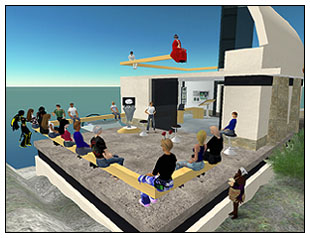
This should come as no surprise, but many of my entries are less direct feeds of net news and more indirect mash-ups of stuff I assimilate, even if the additive is seemingly minor. Getting mixed in with the MSM articles I consume – aside from other articles – are things I read on blogs, conversations in which I engage on net forums, personal emails, and increasingly the experiences I have within the Second Life (SL) virtual simulation.
Last night my little virtual plot played host to a “pre-SL Future Salon” meet-up in preparation for an in-world (and hopefully web-streamed) mini-conference – the first in a series of virtual conferences intended to bring people like myself together to discuss and collaborate on any number of projects. For a “pre-meet” it was surprisingly well-attended. And those in attendance ranged from social anthropologists studying players to casual SL passers-by who were probably being studied. We had an SL journalist and real-world (RL) columnist among us. A RL reality show producer in Los Angeles and a leading member of the cutting edge machinima community in New York (if I recall correctly). Not to be left out, there were SL designers to mirror my real-world design credentials. And of course coders and more.
When that many people with varying talents and expertise and connections come together, it’s difficult to not be aware of the potential for collaboration and cross-pollinization. Last night during the meet, I knew I’d be posting an entry on our virtual get together, and while I wanted to raise that particular point, I wasn’t sure my entry today would be more than just posting a link to some other blog entry (namely the organizer’s, which is here, or the SL journalist’s, which is here). However, having just read two articles something clicked.
The first article, “Teenagers Struggle With Privacy, Security Issues“, over on the SecurityFocus website (linked from Wired), included this bit:
I think it is hard for the parents and educators because we are moving at a different pace than they are… no offense,” said Elizabeth. “It feels like we are done and on to the next thing by the time other people are aware of it.
The second article is an excellent piece over on BusinessWeek online, “Blogs Will Change Your Business“. I highly recommend people read it.
What struck me was that while reading the BW article, I found myself thinking about Elizabeth and her comment – a nice reminder of what most have us have known for years: kids are often more comfortable with new technologies than parents. Taken together with what I witnessed last night, I can only wonder when virtual spaces will get a similar write-up on BW, since so many of the early blogs I recall reading were written by teens. I do suspect it’s sooner rather than later. Why? Here’s a few reasons:
1) Recent news in broadband circles is that DSL is starting to decouple from regular phone services in the U.S. which should reduce service fees and make broadband more accessible. And of course, high-speed connections are exploding in Asia. Add in more efficient compression algorithms and you get content moving around very quickly. One way or another, immersive worlds will find their way into homes.
2) The spin-off of There into a new company with a fresh infusion of capital (and doubtlessly able to benefit from the former parent company’s military work), reinvigorates the competitive game. Without There, non-MMORPG sims would lose a prime motivator. With There, we – as consumers/users – can expect better and more capable simulations from all developers.
3) The continued upgrading of Second Life (including streaming video and external links to webpages) and the reportedly rapid growth in subscribers over the last few months (with the current goal of reaching 1M by 2007 reportedly on track); coupled also with an 1100% growth in the virtual GDP according to CEO Philip Linden (meaning players currently purchase goods from other players at the rate of $80 US per month).
4) My personal observation that many SLer’s are of a demographic that would be very attractive, and surprising, to some companies (especially low-tech commodity manufacturers who rely less on “fashion” than, for example, cell phone manufacturers – although Motorola could easily market inside SL).
5) Advances in videogame technology that filter into regular VR sims either through code or through the hardware requirements many new games force upon their users (no doubt a significant number of PC owners upgraded for Doom3 or Half-Life 2, and those bleeding edge players are the best advertising money can buy).
6) Linden Labs recent opening of a “teen grid” for younger users – in at least some recognition that their future subscribers are currently underage and not able to “play” Second Life on the main grid.
7) The increased appearance of “farm workers” in Second Life (after apparently having become common in most MMORPGs). Whether or not “bosses” want their “players” to learn savvy capitalist techniques in a virtual world (and potentially gain too much knowledge) and continue to expand into non-game sims is a different issue. If they pull their farmers for that reason, I expect they’ll realize they could be making “real” money in other ways. Having worked with Chinese companies, I’ve found them to be very opportunistic!
8) And of course, the recent legitimization of virtual economics by both Microsoft and Sony.
No predictions, but don’t be surprised if things move faster than expected. After all, it’s not like VR hasn’t been a topic for years – including apparently being Timothy Leary’s future drug of choice in the mid-90’s. It’s just been dormant. Waiting for the world’s connectivity to catch up. I’d say we’re almost there.
